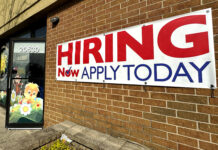NEW YORK – Hiring at the smallest U.S. businesses is moderating, a sign of sluggishness in the economy.
Growth has slowed in some indexes measuring employment at companies with fewer than 20 workers. This deceleration indicates a disconnect in the labor market; payrolls for all nonfarm employers rose at the fastest pace since 2001 in the 12 months through February, based on Labor Department data.
Monitoring the smallest companies is important because they accounted for about 23 percent of all nonfarm private jobs created last year, said Ahu Yildirmaz, head of the ADP Research Institute in Roseland, N.J.
Their payroll growth weakened in January-February, with gains averaging 44,000 compared with 54,700 in all of 2014, according to seasonally adjusted ADP data. March figures are scheduled for release at 8:15 a.m. EST today.
If hiring doesn’t start to improve by June, with warmer weather, that may indicate a more troubling trend.
“We have to wait and see if the numbers will go up,” Yildirmaz said. “There’s nothing happening fundamentally in the economy which would cause this slowdown we’ve seen.”
Basic drivers of demand remain intact: Consumer spending grew last year by the most since 2006, and business owners now have greater access to credit. So the year-to-date sluggishness could reflect severe winter storms and cold, a decline in consumer confidence since Jan. 25 and a potential talent gap of qualified applicants, she said.
Adding jobs
Companies with fewer than 20 workers employ about 21 million Americans, or approximately 18 percent of the workforce, according to Susan Woodward, president and founder of Sand Hill Econometrics in Menlo Park, Calif. She also works with Intuit Inc. on its Small Business Employment Index, which is based on payrolls for about 263,000 customers of the Mountain View, Calif.-based financial-software company.
This indicator was 97.38 last month compared with its pre-recession peak of 100.14 in March 2007, reflecting the “lukewarm” hiring trend, she said.
One reason for the smallest-company stall is “the big decrease in the degree to which people try to start a business,” Woodward said. Regulatory and tax requirements discourage some would-be entrepreneurs, while there’s also “softness” in the number of their full-time employees and hours worked, she said.
Cautionary sign
Another cautionary sign: More than half of executives at the small companies surveyed by the National Federation of Independent Business reported no desire to take out a loan in March, according to the federation. A full report of last month’s economic trends for these businesses is scheduled for release today.
The net difference in businesses reporting actual employment gains rather than cuts for the past three months fell to minus 1 percentage point in March, down from a post-recession high of 9 points in December, federation data show. More than 70 percent of respondents in the monthly survey have 19 or fewer employees.
Even so, there are bright spots. The Paychex-IHS Small Business Jobs Index, at 100.79 last month, remains above pre- recession levels, and first-quarter gains were the highest in a year, said Martin Mucci, CEO of Rochester, N.Y.-based Paychex Inc.
Ups, downs
“While there have been ups and downs” in job growth at employers with fewer than 50 workers, “we’re still feeling pretty positive,” Mucci said. That’s because the index has been above 100 since October 2011, illustrating “robust and consistent gains” for the approximately 350,000 businesses represented, said James Diffley, chief regional economist at IHS Inc.
Hiring in the past two years has been strongest in the west north-central region and particularly robust for health-services and education nationwide, Mucci said. Meanwhile, ADP data show that employment at goods-producing companies has held up, helping to sustain index gains, even as job growth at service-providing businesses has slowed, Yildirmaz said.
Total nonfarm hiring expanded by 245,000 last month, based on the median estimate of economists surveyed by Bloomberg. That would bring the April-March average to about 276,000, the most since 2000, according to data from the Labor Department, which is scheduled to release March results April 3.
So long as there’s not a significant slowdown in retail- sales growth, small-business hiring probably will continue to be “solid, but not spectacular,” said William Dunkelberg, the NFIB’s chief economist. That’s buoyed partly by the federation’s optimism index, which is near the highest since 2006, and a “reasonably good” net difference between owners who plan to increase rather than decrease headcount in the next three months – 10 percentage points as of March.
“This sector is an important engine for the overall economy,” Yildirmaz said.













For a more detailed analysis of the employment/underemployment/ unemployment situation;
Refer to The Bureau Of Labor Statistics; http://www.bls.gov/lau/stalt.htm …which is updated quarterly…
…as of 01/30/2015, Rhode Island’s Employment/Unemployment Rate
of measurement at Level U6 is: THIRTEEN POINT FIVE CENT (13.5%)….
which is down NINE-TENTHS OF ONE PER CENT (.09%) from last quarter’s measurement…
….and as of 03/06/2015, the National Employment/Unemployment
Rate of measurement at Level U6 is: ELEVEN PER CENT (11.0%)…
(further details can be found at http://www.bls.gov/news.release/empsit.t15.htm which is updated monthly….)
The next publication of the employment/underemployment/unemployment situation, broken down by State level,
covering the previous four quarters ending in March 2015, is tentatively scheduled for Friday, April 24, 2015, so stay tuned….